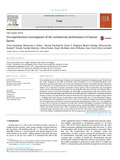JavaScript is disabled for your browser. Some features of this site may not work without it.
| dc.contributor.author | Onabanjo, Tosin | |
| dc.contributor.author | Kolios, Athanasios | |
| dc.contributor.author | Patchigolla, Kumar | |
| dc.contributor.author | Wagland, Stuart Thomas | |
| dc.contributor.author | Fidalgo Fernandez, Beatriz | |
| dc.contributor.author | Jurado Pontes, Nelia | |
| dc.contributor.author | Hanak, Dawid P. | |
| dc.contributor.author | Manovic, Vasilije | |
| dc.contributor.author | Parker, Alison | |
| dc.contributor.author | McAdam, Ewan J. | |
| dc.contributor.author | Williams, Leon | |
| dc.contributor.author | Tyrrel, Sean F. | |
| dc.contributor.author | Cartmell, Elise | |
| dc.date.accessioned | 2016-08-15T13:57:41Z | |
| dc.date.available | 2016-08-15T13:57:41Z | |
| dc.date.issued | 2016-07-27 | |
| dc.identifier.citation | Onabanjo T, Kolios A, Patchigolla K, et al., (2016) An experimental investigation of the combustion performance of human faeces. Fuel, Volume 184, November 2016, pp. 780-791 | en_UK |
| dc.identifier.issn | 0016-2361 | |
| dc.identifier.uri | http://dx.doi.org/10.1016/j.fuel.2016.07.077. | |
| dc.identifier.uri | http://dspace.lib.cranfield.ac.uk/handle/1826/10302 | |
| dc.description.abstract | Poor sanitation is one of the major hindrances to the global sustainable development goals. The Reinvent the Toilet Challenge of the Bill and Melinda Gates Foundation is set to develop affordable, next-generation sanitary systems that can ensure safe treatment and wide accessibility without compromise on sustainable use of natural resources and the environment. Energy recovery from human excreta is likely to be a cornerstone of future sustainable sanitary systems. Faeces combustion was investigated using a bench-scale downdraft combustor test rig, alongside with wood biomass and simulant faeces. Parameters such as air flow rate, fuel pellet size, bed height, and fuel ignition mode were varied to establish the combustion operating range of the test rig and the optimum conditions for converting the faecal biomass to energy. The experimental results show that the dry human faeces had a higher energy content (∼25 MJ/kg) than wood biomass. At equivalence ratio between 0.86 and 1.12, the combustion temperature and fuel burn rate ranged from 431 to 558 °C and 1.53 to 2.30 g/min respectively. Preliminary results for the simulant faeces show that a minimum combustion bed temperature of 600 ± 10 °C can handle faeces up to 60 wt.% moisture at optimum air-to-fuel ratio. Further investigation is required to establish the appropriate trade-off limits for drying and energy recovery, considering different stool types, moisture content and drying characteristics. This is important for the design and further development of a self-sustained energy conversion and recovery systems for the NMT and similar sanitary solutions. | en_UK |
| dc.language.iso | en | en_UK |
| dc.publisher | Elsevier | en_UK |
| dc.rights | Attribution 4.0 International | en_UK |
| dc.rights.uri | http://creativecommons.org/licenses/by/4.0/ | |
| dc.subject | Faecal biomass | en_UK |
| dc.subject | Combustion | en_UK |
| dc.subject | Smouldering | en_UK |
| dc.subject | Non-sewered sanitary systems | en_UK |
| dc.subject | Nano membrane toilet | en_UK |
| dc.title | An experimental investigation of the combustion performance of human faeces | en_UK |
| dc.type | Article | en_UK |
| dc.identifier.cris | 15023102 |
Files in this item
This item appears in the following Collection(s)
-
Staff publications (SWEE) [2825]

